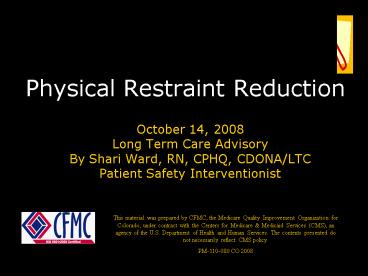Physical Restraint Reduction - PowerPoint PPT Presentation
1 / 14
Title:
Physical Restraint Reduction
Description:
40% of nursing home admissions are at least in part related to falls ... Use the following codes for last 7 days. 2. Used daily (Colorado MDS Item-by-Item Data) ... – PowerPoint PPT presentation
Number of Views:1341
Avg rating:3.0/5.0
Title: Physical Restraint Reduction
1
Physical Restraint Reduction
- October 14, 2008
- Long Term Care Advisory
- By Shari Ward, RN, CPHQ, CDONA/LTC
- Patient Safety Interventionist
This material was prepared by CFMC, the Medicare
Quality Improvement Organization for Colorado,
under contract with the Centers for Medicare
Medicaid Services (CMS), an agency of the U.S.
Department of Health and Human Services. The
contents presented do not necessarily reflect CMS
policy. PM-110-080 CO 2008
2
What are Residents, Family and Staff Seeking?
- Quality of life, not just quality of care
- Staff who are respectful and well trained
- Most of all Staff who care
- They want to help.
- They are kind and good to me.
- There are enough of them.
- They are friendly and cheerful.
- They are patient and have time for me.
- National Citizens' Coalition for Nursing Home
Reform (NCCNHR), 1985 - Tellis-Nayak and Tellis-Nayak, 2005
3
What makes staff think about using restraints?
- Fear of being cited by surveyors for failure to
protect resident from harm - They think they will work to protect the resident
from harm - They think it is better than not using them
- They think it cant hurt
- They think it might prevent other problems
(wandering, residents getting into altercations) - They think it will make their job easier so they
can take better care of other residents
4
What should staff be thinking about?
- Root cause why was the resident trying to get
up, walk, lean over, engage in an activity in
the first place????
5
Some Statistics
- 35-40 of community-dwelling, generally healthy
adults over age 65 fall annually - Rates are higher after age 75
- In nursing homes and hospitals, rates are almost
three times higher (1.5 falls per bed) - 50 of fallers do so repeatedly
6
Statistics
- Fall-related injuries recently accounted for 6
of all medical expenditures for persons age 65
and older - Fall-related injuries may cost up to 20 billion
dollars/year in acute care and institutionalizatio
n - 40 of nursing home admissions are at least in
part related to falls
7
P4. Devices RestraintsUse the following codes
for last 7 days2. Used daily (Colorado MDS
Item-by-Item Data)
8
Management of Falls Restraints
- Fall prevention management and restraint
reduction go hand in hand. - Management and leadership need to be committed to
improving QMs for both falls and restraints. - Begin with an assessment of where your facility
is now, where the gaps are, and how you will
implement the first phase of your program (use
facility and systems checklists).
9
Source Quality Indicator OLAP Cube
10
National QIO Falls Management Program
- Has many downloadable forms, including policies
and procedures - Can be easily adapted or customized to your
facility - www.medqic.org (Enter falls management program
as a search term)
11
Source 2007 Q3 2007 Q4 Standard Analytic
Reports
12
Source 2003 Q3 2007 Q4 Standard Analytic
Reports
13
(No Transcript)
14
Colorado Foundation for Medical
Care www.cfmc.org Shari Ward, Patient Safety
Interventionist Sward_at_coqio.sdps.org 303-669-9581
Betsy Willy Betsy.willy_at_pathwayhealth.com Laura
Koski-Mankin, Project Assistant Lkoski_at_coqio.sdps.
org 303-695-3300, ext. 3345 For Additional
Clinical Information www.qualitynet.org/MedQIC
www.nhqualitycampaign.org































